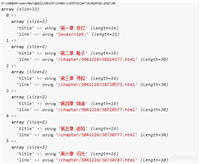说通俗点,php中使用trait关键字是为了解决一个类既想集成基类的属性和方法,又想拥有别的基类的方法,而trait一般情况下是和use搭配使用的。
<?php
trait drive {
public $carname = 'trait';
public function driving() {
echo "driving {$this->carname}\n";
}
}
class person {
public function eat() {
echo "eat\n";
}
}
class student extends person {
use drive;
public function study() {
echo "study\n";
}
}
$student = new student();
$student->study();
$student->eat();
$student->driving();
?>
输出结果如下:
study eat driving trait
上面的例子中,student类通过继承person,有了eat方法,通过组合drive,有了driving方法和属性carname。
如果trait、基类和本类中都存在某个同名的属性或者方法,最终会保留哪一个呢?
<?php
trait drive {
public function hello() {
echo "hello drive\n";
}
public function driving() {
echo "driving from drive\n";
}
}
class person {
public function hello() {
echo "hello person\n";
}
public function driving() {
echo "driving from person\n";
}
}
class student extends person {
use drive;
public function hello() {
echo "hello student\n";
}
}
$student = new student();
$student->hello();
$student->driving();
?>
输出结果如下:
hello student driving from drive
因此得出结论:当方法或属性同名时,当前类中的方法会覆盖 trait的 方法,而 trait 的方法又覆盖了基类中的方法。
如果要组合多个trait,通过逗号分隔 trait名称:
use trait1, trait2;
如果多个trait中包含同名方法或者属性时,会怎样呢?答案是当组合的多个trait包含同名属性或者方法时,需要明确声明解决冲突,否则会产生一个致命错误。
<?php
trait trait1 {
public function hello() {
echo "trait1::hello\n";
}
public function hi() {
echo "trait1::hi\n";
}
}
trait trait2 {
public function hello() {
echo "trait2::hello\n";
}
public function hi() {
echo "trait2::hi\n";
}
}
class class1 {
use trait1, trait2;
}
?>
输出结果如下:
使用insteadof和as操作符来解决冲突,insteadof是使用某个方法替代另一个,而as是给方法取一个别名,具体用法请看代码:
<?php
trait trait1 {
public function hello() {
echo "trait1::hello\n";
}
public function hi() {
echo "trait1::hi\n";
}
}
trait trait2 {
public function hello() {
echo "trait2::hello\n";
}
public function hi() {
echo "trait2::hi\n";
}
}
class class1 {
use trait1, trait2 {
trait2::hello insteadof trait1;
trait1::hi insteadof trait2;
}
}
class class2 {
use trait1, trait2 {
trait2::hello insteadof trait1;
trait1::hi insteadof trait2;
trait2::hi as hei;
trait1::hello as hehe;
}
}
$obj1 = new class1();
$obj1->hello();
$obj1->hi();
echo "\n";
$obj2 = new class2();
$obj2->hello();
$obj2->hi();
$obj2->hei();
$obj2->hehe();
?>
输出结果如下:
trait2::hello trait1::hi trait2::hello trait1::hi trait2::hi trait1::hello
as关键词还有另外一个用途,那就是修改方法的访问控制:
trait 也能组合trait,trait中支持抽象方法、静态属性及静态方法,测试代码如下:
<?php
trait hello {
public function sayhello() {
echo "hello\n";
}
}
trait world {
use hello;
public function sayworld() {
echo "world\n";
}
abstract public function getworld();
public function inc() {
static $c = 0;
$c = $c + 1;
echo "$c\n";
}
public static function dosomething() {
echo "doing something\n";
}
}
class helloworld {
use world;
public function getworld() {
return 'get world';
}
}
$obj = new helloworld();
$obj->sayhello();
$obj->sayworld();
echo $obj->getworld() . "\n";
helloworld::dosomething();
$obj->inc();
$obj->inc();
?>
输出结果如下:
hello world get world doing something 1 2
以上就是本文的全部内容,希望对大家的学习有所帮助,也希望大家多多支持移动技术网。
如对本文有疑问,请在下面进行留言讨论,广大热心网友会与你互动!! 点击进行留言回复

YII2框架中使用RBAC对模块,控制器,方法的权限控制及规则的使用示例


YII2框架中ActiveDataProvider与GridView的配合使用操作示例


PhpStorm的使用教程(本地运行PHP+远程开发+快捷键)

网友评论